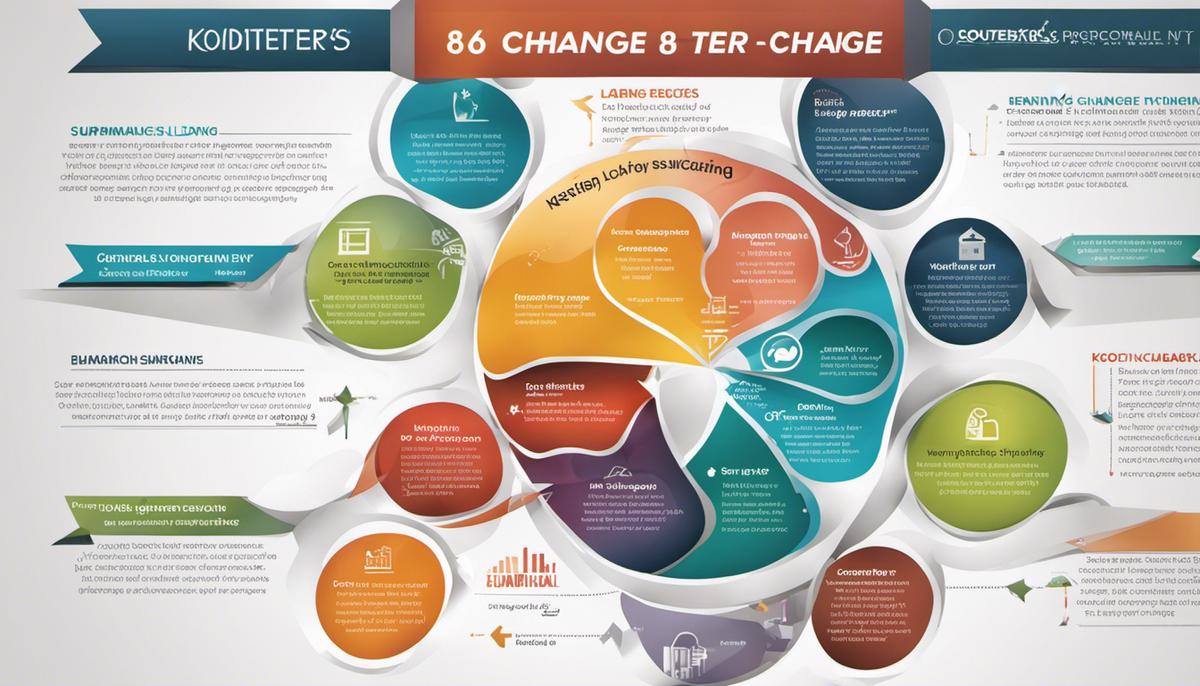In a rapidly transforming business landscape, effective change management is pivotal to organizational agility and survival. At the forefront of the discourse on driving change is John Kotter, a preeminent figure in organizational behavior and leadership. Delving into Kotter’s perspective provides a lens through which the complexities of managing change can be better understood. Consequently, this essay serves as a comprehensive guide to demystifying the groundwork of Kotter’s change management, the renowned 8-Step Process for Leading Change, and the strengths and weaknesses inherent in Kotter’s approach. Moreover, the discussion extends to the application of Kotter’s model to the modern business environment, forging a path through potential challenges. A holistic exploration of Kotter’s approach vis-a-vis other prominent change management theories lends a broader perspective, elucidating the variegated terrain of change management methodologies.
Understanding John Kotter’s Perspective on Change Management
Who is John Kotter?
John Kotter is an esteemed thought leader in business, leadership, and change. He is the Konosuke Matsushita Professor of Leadership, Emeritus at Harvard Business School, where he became a faculty member in 1972. Renowned for his expertise in change management, his theories have guided countless organizations through the challenging process of change.
Kotter’s Professional Background and Contribution to Change Management
Throughout his career, Kotter has authored 18 books, many of which are bestsellers. “Leading Change” (1996) is one of his most influential works, outlining an eight-step process for managing change in organizations effectively.
Beyond academia, Kotter is the co-founder of Kotter International, a management consulting firm that applies his proprietary methodologies to help clients lead change in their organizations. He is respected globally for his groundbreaking research and knowledge about the management of change in corporations and other organizations.
Kotter’s Perspective on Change Management
Kotter’s perspective on change management is profound and straightforward. He argues that change is inevitable and necessary for growth but often mishandled or misunderstood in organizations, leading to resistance and ultimately failure.
He believes that most organizations are over-managed and under-led, especially during times of change. In his view, leadership, not just management, is critical in driving change. He holds that while management involves planning and budgeting, leadership involves setting direction and aligning people.
His core philosophy is encapsulated in his famous eight-step model for leading change. These steps include:
- Establishing a sense of urgency;
- Forming a powerful guiding coalition;
- Creating a vision;
- Communicating the vision;
- Empowering others to act on the vision;
- Planning for and creating short-term wins;
- Consolidating improvements and producing more change; and finally,
- Institutionalizing new approaches.
The Impact of John Kotter’s Change Management Principles
John Kotter’s indisputable influence on change management practices continues to resonate due to the perpetual shifts in business landscapes. Companies are compelled to evolve and transform to maintain their competitiveness and relevance, and Kotter’s theories offer the necessary practical guidance. His clear, implementable advice equips managers with the tools they need to steer their organizations through periods of change.
The teachings of Kotter remain a key aspect of change management theory and application. Leaders and managers worldwide consistently utilize his concepts and methods, helping to solidify his reputation as one of the most influential figures in contemporary management theory.

Kotter’s 8-Step Process for Leading Change
Diving into Kotter’s 8-Step Change Management Approach
John Kotter, now a retired Harvard Business School professor, is globally recognized as an authority on leadership and change. He developed the “Kotter’s 8-Step Process,” a concrete model for effective change management. Countless businesses have found value in this structured framework, utilizing it as an effective tool to manage the challenges that organizational change often brings.
Step 1: Create a Sense of Urgency
The first step entails persuading stakeholders the change is essential. Kotter believed it was crucial to inspire a desire for change to motivate action. Consider the scenario of IBM in the early 1990s. The company was rigid and slow to respond to the market changes until the CEO Lou Gerstner, Jr. declared an emergency, sparking action.
Step 2: Build a Guiding Coalition
Kotter suggests identifying key influencers within your organization and encouraging them as change advocates. He stressed the importance of working as a team. An example of a successful coalition is when Steve Jobs returned to Apple and assembled a new management team.
Step 3: Form a Strategic Vision and Initiatives
Kotter proposed that when stakeholders understand the purpose behind the change, they are more likely to buy into it. This strategic vision must be clear and shared. The Ford Motor Company’s turnaround led by Alan Mulally is a great example. Mulally’s vision was to create a One Ford image, which was simple, compelling, and far-reaching in its applications.
Step 4: Enlist a Volunteer Army
Kotter’s fourth step is about cascading messages and values down to grassroots so that everyone in the organization understands the vision and concepts of change. A case in point is Procter and Gamble’s turnaround in the early 2000s, led by A.G. Lafley. Lafley involved the entire organization in innovation and transformation.
Step 5: Enable Action by Removing Barriers
To enact change, unnecessary obstacles need to be removed. Per Kotter, organizations should foster an environment that encourages risk and non-traditional ideas, activities, and actions. A prime example is Pixar, which established a culture of open and candid communication to stimulate creativity and reduce barriers.
Step 6: Generate Short-Term Wins
Kotter believed in celebrating small, early changes as a way to motivate the team and demonstrate the feasibility of the overall change. In Ford’s turnaround, Mulally applied this strategy where he celebrated the repayment of debt ahead of schedule.
Step 7: Sustain Acceleration
Change programs can be exhausting. To avoid backlash or fatigues, Kotter argued for using early wins as evidence of success and using it to tackle bigger and more complex change projects. Google’s continuous and iterative improvement of its Search attributes exemplifies this principle.
Securing Lasting Change: The Final Stage
In the journey towards effecting lasting organizational changes, one of the critical steps is instituting the alterations to make them a part of the corporate culture. These changes should not be temporary but rather be ingrained in the behaviors and standard practices across the organization. The application of this principle can be seen in Microsoft’s evolution towards a more cloud-centric and open-source model under the leadership of CEO Satya Nadella. Acknowledging and rewarding behaviors that support these changes also play an integral role in ensuring continuity and longevity.

Strengths and Weaknesses of Kotter’s Model
Grasping the Core Strengths of Kotter’s Eight-Stage Process
The reason behind the resounding success of John Kotter’s Eight-Stage Process is its systematic and precise structure, which outlines a linear, straightforward path to achieving successful organizational change. The real genius of this model is its simplicity paired with its holistic perspective.
The model starts with establishing a sense of urgency, which is then followed by creating and empowering a coalition to guide the change. Next comes the articulation of a vision, which must be communicated widely to gain universal understanding and acceptance. Overcoming resistance and celebrating short-term victories are then used to maintain momentum. These steps culminate in the incorporation of the change into the organizational culture, thus ensuring sustainability. The systematic, stage-wise approach makes the transformation process organized and efficient.
Moreover, Kotter’s model emphasizes the essential role of strong leadership in the change process. Leaders are charged with engaging the entire organization in the transformation journey, promoting a culture of unity and collective ownership. This heavy reliance on leadership aligns neatly with modern notions of the pivotal role effective leadership plays, particularly during periods of significant change.
Limits of Kotter’s Model
Kotter’s model certainly presents numerous advantages, however, like any approach, it carries its own set of limitations. A key issue arises in its applicability to all types of organizations. While large firms might find it beneficial and feasible to execute all eight stages, this model becomes cost-prohibitive and time-consuming for smaller entities, often leaving them grappling with the allocation of their limited resources.
Additionally, change can be multifaceted and unpredictable with elements that are impossible to plan for or control. In such scenarios, the sequential, rigid structure endorsed by the Kotter Model may inhibit the flexibility and creativity needed to adapt to the evolving business landscape.
The model’s overemphasis on leadership presents another challenge. Placing too much responsibility on key individuals may expose the model to the potential risks of those leaders’ failings or their departure during the change process. This can seriously compromise the efficiency of the change and can even bring the process to a sudden halt.
Kotter’s model is also often criticized for being devoid of a robust review mechanism. Despite recognizing significant steps in formulating and accomplishing goals, it doesn’t provide a clear feedback method, thereby leaving organizations clueless about the failure of a strategy. Consequently, this could lead to squandered resources or negligible progression, undermining overall support for the change.
In a nutshell, while Kotter’s model triumphs in being systematic, user-friendly, and emphasizing the importance of leadership, it has its downsides. These include its inflexibility, excessive dependence on pivotal individuals, and the absence of a feedback loop. Understanding these pros and cons aids in determining its most effective application in managing organizational change.

Applying Kotter’s Model in Today’s Business Environment
Adapting Kotter’s Model for the Modern Business Landscape
Step 1: Building a Sense of Urgency
This initial step revolves around instilling the understanding of the urgency of change. Given the rapid pace of the contemporary business world, organizations must pinpoint market opportunities and potential crises that warrant change. This proactive approach involves scrupulous evaluation of potential threats, consideration of probable outcomes, and assessment of available opportunities to ensure a beneficial outcome.
Step 2: Creating the Guiding Coalition
This step involves forming a coalition with enough power to lead the change. The coalition needs to be composed of diverse stakeholders who have a broad understanding of the organization’s workings. Diversity within this coalition fosters innovation and can help to navigate the complexities of modern business proposals.
Step 3: Developing a Vision and Strategy
The third step involves establishing the direction in which the organization needs to move and strategize how to achieve that. Defining a clear, understandable, and feasible vision for the organization’s future is instrumental in navigating the challenges presented by rapidly evolving industries and markets.
Step 4: Communicating the Change Vision
Once the vision is formulated, it must be communicated effectively across the organization. Transparent and regular communication is even more important in an environment marked by changing technologies and global workplace dynamics.
Step 5: Empowering Broad-Based Action
This step involves eliminating obstacles that could undermine the vision. In today’s context, this often means dealing with complexities arising from technological advancements and navigating the challenges of globalization.
Step 6: Generating Short-Term Wins
Recognizing and celebrating progress is key to keeping the momentum going. Kotter argues that recording, communicating, and celebrating ‘wins’ is vitally important, especially in an era where business conditions are constantly in flux.
Step 7: Consolidating Gains and Producing More Change
In this phase, the change process becomes an integral part of the corporate culture. This step is particularly pertinent to today’s environment where change is not a one-time event, but a recurring necessity.
Completion of the Process: Anchoring New Approaches in Organizational Culture
The final leg of the journey involves solidifying the changes by firmly rooting them in the culture of the organization. This crucial step guarantees that the newly adopted methods and strategies are not only accepted but are deeply ingrained in the collective values and social norms of the company.

Comparing Kotter’s Model with Other Change Management Theories
Navigating Change Management: Comparing Kotter’s Model with Other Theories
As a seasoned professional, it is essential to understand that John Kotter’s 8-Step Process for Leading Change ranks highly among the most influential frameworks in the field of change management. This model underscores the importance of nurturing a sense of urgency, building a guiding coalition, crafting a strategic vision, and effectively communicating this vision. Furthermore, it promotes the facilitation of action by eliminating obstacles, celebrating short-term victories, maintaining momentum, and most importantly, embedding the adopted changes within the organization’s culture.
Lewin’s Change Management Model
One of the earliest models is Kurt Lewin’s Change Management Model, suggesting the three stages of Unfreeze, Change, and Refreeze. Unfreeze involves dissolving the structures in place, making employees ready for change. The Change phase involves executing the change with new behaviors, processes, and thinking. Finally, Refreeze is where the new changes become the standard.
Comparatively, Lewin’s model is more simplistic than Kotter’s. While it doesn’t outline factors such as “creating a guiding coalition,” it shares some elements with Kotter’s, such as getting buy-in from team members (Unfreeze stage) and embedding the changes into the fabric of the organization (Refreeze stage).
McKinsey 7-S Model
The McKinsey 7-S model is another distinguished approach, which considers seven inherent aspects of an organization for effective change: Strategy, structure, systems, shared values, skills, style, and staff. Unlike Kotter’s, McKinsey’s model does not provide a step-by-step process.
However, it overlaps with Kotter’s model when considering establishing shared values, staffing and aligning people to a change vision. Kotter’s “developing a strategic vision” and “communicating the vision” overlaps with the 7-S model’s focus on developing a encompassing strategy.
ADKAR Model
The ADKAR model (Awareness, Desire, Knowledge, Ability, and Reinforcement) offers a bottom-up individual-focused approach in contrast to Kotter’s organization-wide top-down strategy. Like Kotter’s model, ADKAR stresses the importance of communication (“Awareness”) and reinforcement to ensure that changes stay in place.
Commonalities and Differences
While all models differ in their approaches, they each underscore the importance of communication in facilitating change and reinforce changes to ensure they stick. Kotter’s model uniquely offers a strategic step-by-step framework, detailing the process from inception to completion, which many other models do not explicitly outline. It demands proactive leadership and a unified, resolute team driving change, a perspective less highlighted in the other models.
Overall, the suitability of any model depends largely on the organization’s unique situation and the type of change intended. Various strengths and weaknesses between these models provide a broader perspective on change management practices.

Embracing change is not just about absorbing a new set of rules, but it’s about fostering a culture that values continuous evolution for success. John Kotter’s change management perspective and his 8-Step Process for Leading Change provide an insightful roadmap for organizations to navigate through this often rocky landscape. While the practicality of Kotter’s model has its strengths and limitations, its application is instrumental in a range of business contexts. Further, juxtaposing Kotter’s approach with other prevailing change management theories enhances the understanding of its place within the bigger picture. Nonetheless, regardless of the change management model adopted, the central idea remains the same – change, managed thoughtfully and effectively, is instrumental in propelling organizations forward, amid the dynamics of the global business stage.
